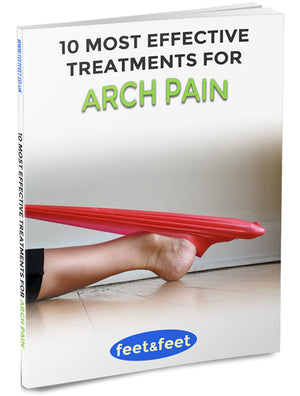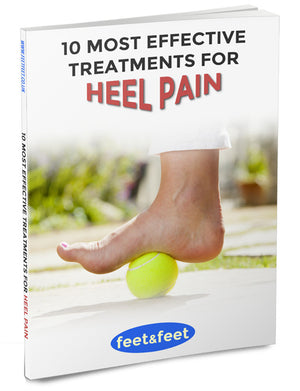Top 7 Tips For Choosing Plantar Fasciitis Insoles

The most common type of heel pain is known as plantar fasciitis, which occurs when the plantar fascia – the tissue that supports the arch of the foot – weakens or gets inflamed.
A common and effective treatment for plantar fasciitis is a supportive pair of plantar fasciitis insoles that are designed to have the right amount of arch support to distribute pressure more evenly and stabilise the relevent bones within the arch. This means less tension, stress and pain for the plantar fascia.
Before you rush out and buy a pair of insoles for your plantar fasciitis, read the following tips first.
1. Find Out What Works For You
Everyone’s feet is different and suffering from plantar fasciitis is not as simple as selecting a “one size fits all” insole. You may have noticed that there are plenty of different types of insoles and orthotics for plantar fasciitis – low arch, mid-height arch, high arch, long arch, short arch, full insoles, half insoles and so forth.
Depending on the severity of your condition, you would have to choose an insert that suits your feet accordingly. Typically, you’d want to avoid insoles with too much arch support as it can cause other foot issues.
2. Avoid Highly Flexible Insoles
It’s important to select a pair of insoles that are firm and rigid towards the arch and heel because it increases support and stability. The last thing you want is for the arches to be constantly moving and collapsing whenever you’re walking.
One exception for selecting slightly flexible and soft insoles is if the back of your shoes are very rigid. In this case, it would probably be more comfortable to do so.
Please keep in mind that your insoles and shoes should always be flexible to allow free and natural movement of all the toes.
3. Consider Insoles With Shock Absorbing Heel Cups
Some plantar fasciitis insoles and inserts have little support towards the back heel while some do. Selecting a pair that does have a good amount of support and cushioning at the heel cup helps to keep the fat pad within the heels squeezed together.
As a result, this helps to lessen the impact on the plantar fascia and relieve the pain. Despite how well constructed the heel cup is, it doesn’t actually help to structure your bones and joints to be in more stable positions, therefore it won’t fix or improve the condition of plantar fasciitis itself.
4. Wear Footwear With Wide Toe Boxes
There are two main reasons for wearing shoes with wide toe boxes. The first one being that if you decide to insert full sized insoles, then you need to ensure that there’s enough space for them. However, this wouldn’t be too much of an issue if the insoles were designed to be trimmed.
The second and more important reason is because there needs to be enough room for your transverse arch to expand whenever you take a step. This lesser known arch spans the entire width of the foot from side-to-side and needs enough space to move.
Having a small toe box means that your feet – particularly the toes – are going to be under more pressure and be more restricted which can cause certain toe conditions such as bunions and hammer toes.
5. Match the Insoles With the Shoes
Whether you buy a pair of full size or half size insoles, heel cups or any other orthotics, it’s crucial that they properly fit the footwear you plan on wearing. There needs to be enough room as an insert will alter the fitting of your footwear.
When inserting a pair of insoles, you must first remove the insoles that come with the footwear and replace it with the new ones.
However, some footwear don’t allow you to remove the insoles, and if there’s not enough room for your feet to move around after inserting your new plantar fasciitis insoles, then you need to wear another pair of shoes.
6. Do Not Rely On Plantar Fasciitis Orthotics or Insoles
The only time you should rely on orthotics or insoles for your plantar fasciitis is when your feet feels painful and weak.
A permanent reliance on them can actually make your feet weaker since your feet doesn’t work nearly as hard as it should if you were wearing ordinary footwear without support.
You want to support the arch for as long as it’s necessary and not any longer. As the pain level decreases, you can start wearing less and less supportive insoles; this also applies for supportive shoes too.
7. Effectiveness is Not Based On Price
A really expensive pair of plantar fasciitis orthotics or insoles doesn’t make it any better than something that’s half or even quarter of the price. This goes back to our previous point of finding out what works for you. You should try out several different types of insoles to find out which one feels right.
If you don’t have time to do that or you just want to buy online, then you’d have to make a calculated decision based on the information provided and pictures of the insoles in different angles.

What Are the Best Supports For Plantar Fasciitis?
Even though specially designed insoles are the most widely used type of support for plantar fasciitis, there is a wide range of other products that are also designed to support the arch and heel. Let’s take a brief look at how effective these other types of supports are.
Insoles and Inserts
Support Rating: 5/5
In this article, we’ve already discussed some of the benefits of using insoles and inserts for plantar fasciitis. There is a wide variety of different designs to choose from, from insoles designed for everyday wear to ones made for sports.
Many of the full sized plantar fasciitis insoles can be trimmed down to size, and inserts should fit a bit more snugly unless it’s bulky or your footwear is too narrow. Starting price points can vary and doesn’t always depict their level of quality and effectiveness.
Heel Pads and Cups
Support Rating: 3.5/5
Typically constructed from silicone, heel pads and cups are designed to alleviate pressure and absorb shocks on the heel. The terms of heel pad and cup are often used synonymously, but there’s a slight difference as heel pads tend to be flatter whereas heel cups are larger at the rear and wrap around the heel closer.
They offer little to no arch support, so are usually not as effective as insoles and insoles, but they’re cheaper and more compact in size allowing them to easily fit into most types of footwear.

Splints and Braces
Support Rating: 4/5
Splints and braces used to treat plantar fasciitis are designed to stretch and stabilise the plantar fascia. They typically have a hard outer shell to completely immobilise movement and a soft padded inside for a comfortable and contoured fit, while velcro straps keeps your foot in place.
Some splints and braces have a vertical strap which can be adjusted to give a gentle stretch to the plantar fascia, while some other designs achieve via a flexible bar integrated within the fabric.
The larger and rigid models are intended to be used at home when you’re seated or in bed, and due to their big and bulky design, you’ll be made immobile which is why many users prefer to wear a splint when they sleep.

Plantar Fasciitis Socks
Support Rating: 2/5
Also referred to as compression socks, socks for plantar fasciitis have more underfoot cushioning to alleviate pressure, and their compression qualities are designed to compress the heel and/or arch at certain points to provide some relief from pain and swelling, as well as increase blood circulation.
Though compression socks are sometimes marketed towards treating plantar fasciitis, they’re more ideal for other conditions such as edema, deep vein thrombosis (DVT), economy class syndrome (ECS) and phlebitis.
Plantar Fasciitis Shoes and Trainers
Support Rating: 5/5
Footwear that is catered towards treating plantar fasciitis can be expensive as there’s a more sophisticated design and manufacturing process that goes into it, particularly for running shoes.
And when it comes to choosing the right footwear for plantar fasciitis, it can be just a complicated as you must take into consideration how well it fits, if it’s too heavy or bulky, whether there’s enough cushioning, if there’s enough support for the arch and heel, among other elements. Trying the shoes on for a short period of time should put some of these questions to rest.
Wearing supportive footwear is absolutely vital if you suffer from plantar fasciitis and having the right pair would mean that there’s no need to buy other insoles or inserts, unless your existing ones are worn out.

Custom Orthotics
Support Rating: 5/5
By far the most expensive option are custom made orthotics, which can come in the form of insoles, inserts, heel cups, splints and braces. The materials used largely depend on what type of orthotic you’re getting custom made, and it can be rigid plastic or soft foam or a combination of different materials. Creating a custom orthotic often requires specialist knowledge so that the foot can be set in the most ideal position for recovery.
Choosing the Best Plantar Fasciitis Insoles
One last note when it comes to choosing inserts for plantar fasciitis is that you do not necessarily need a custom made orthotic, even if it’s recommended by your podiatrist.
These are usually very expensive and are often not necessary for the average person with general heel pain; the ready-made plantar fasciitis insoles available will be just as effective if not more.






Comments
Leave a comment